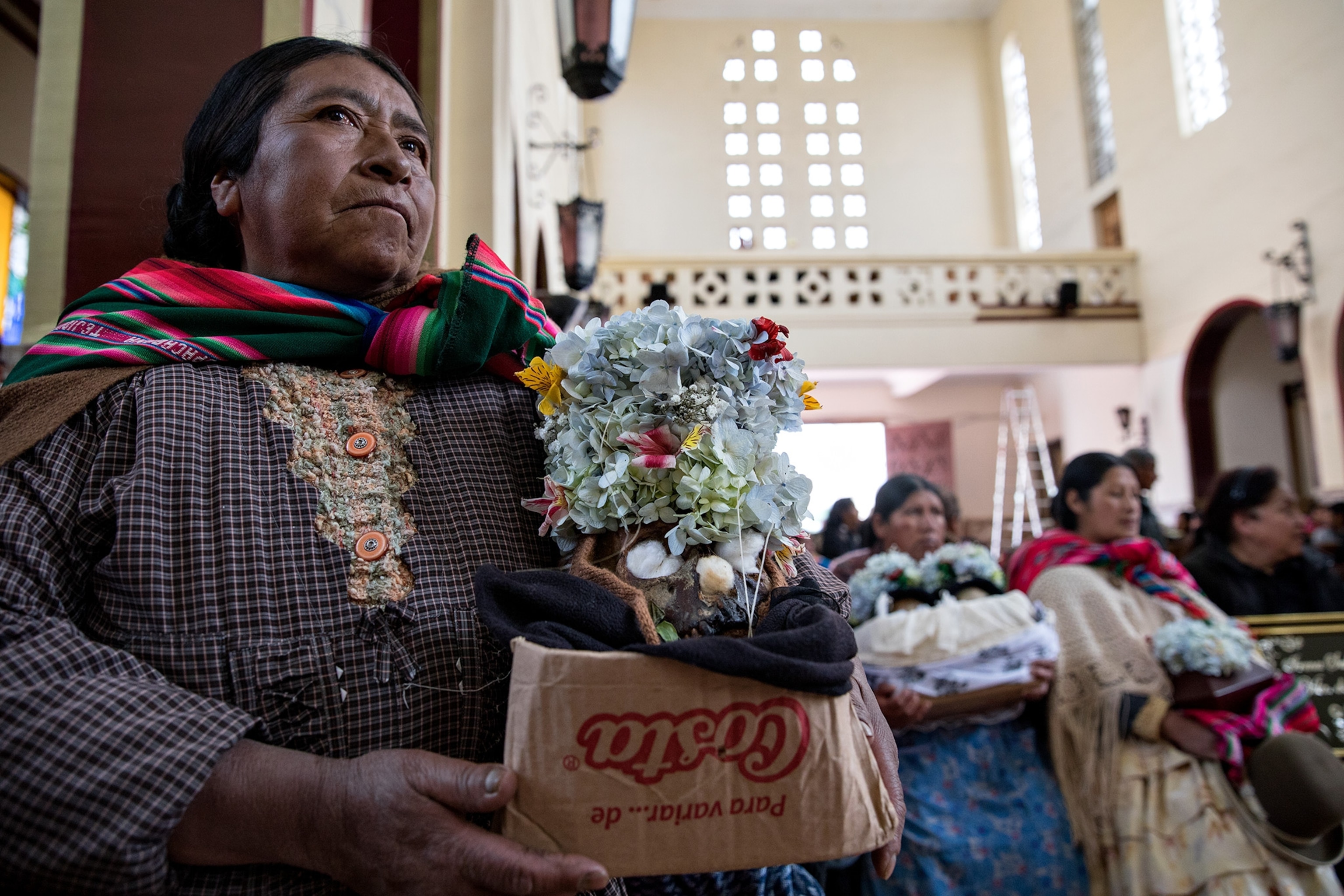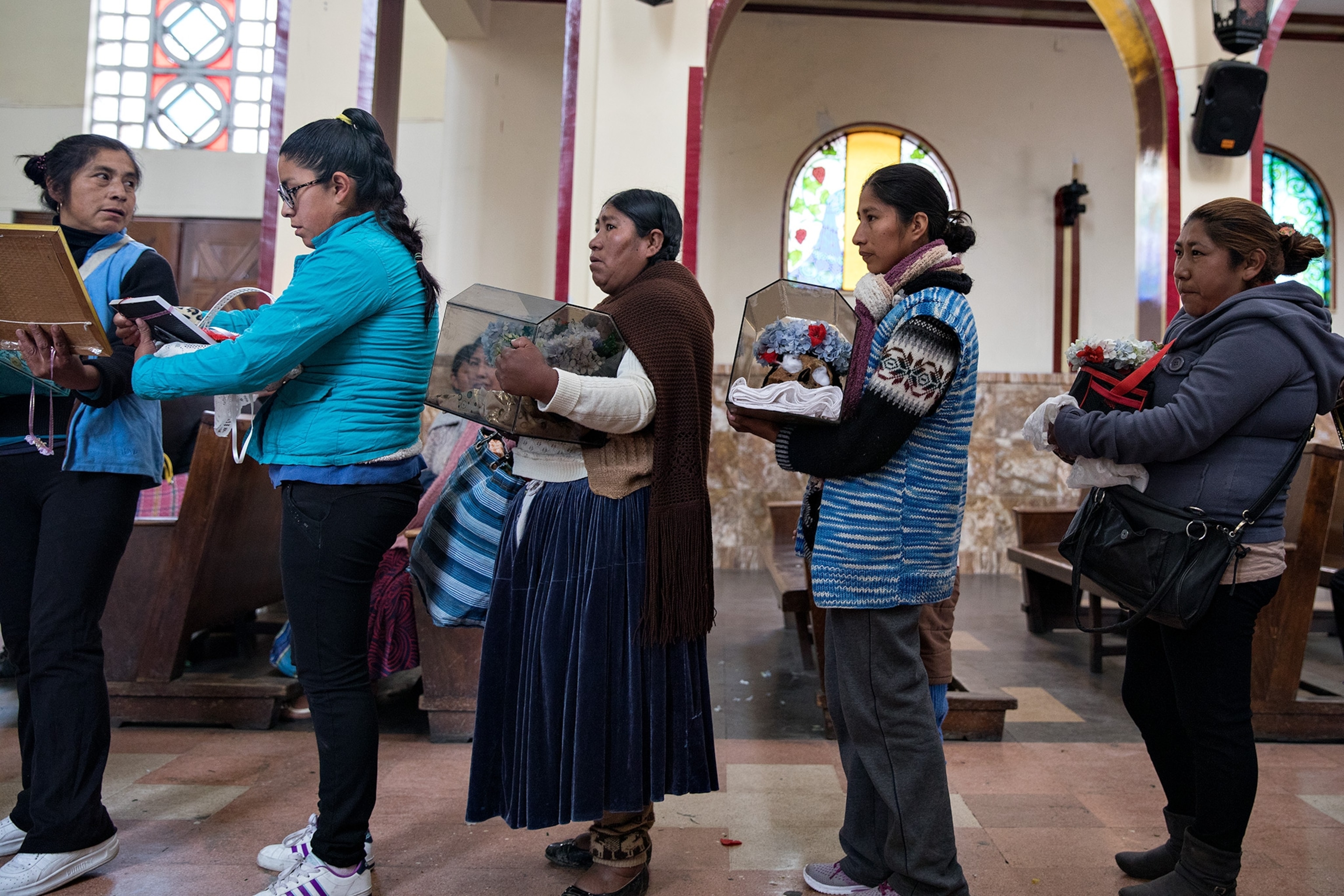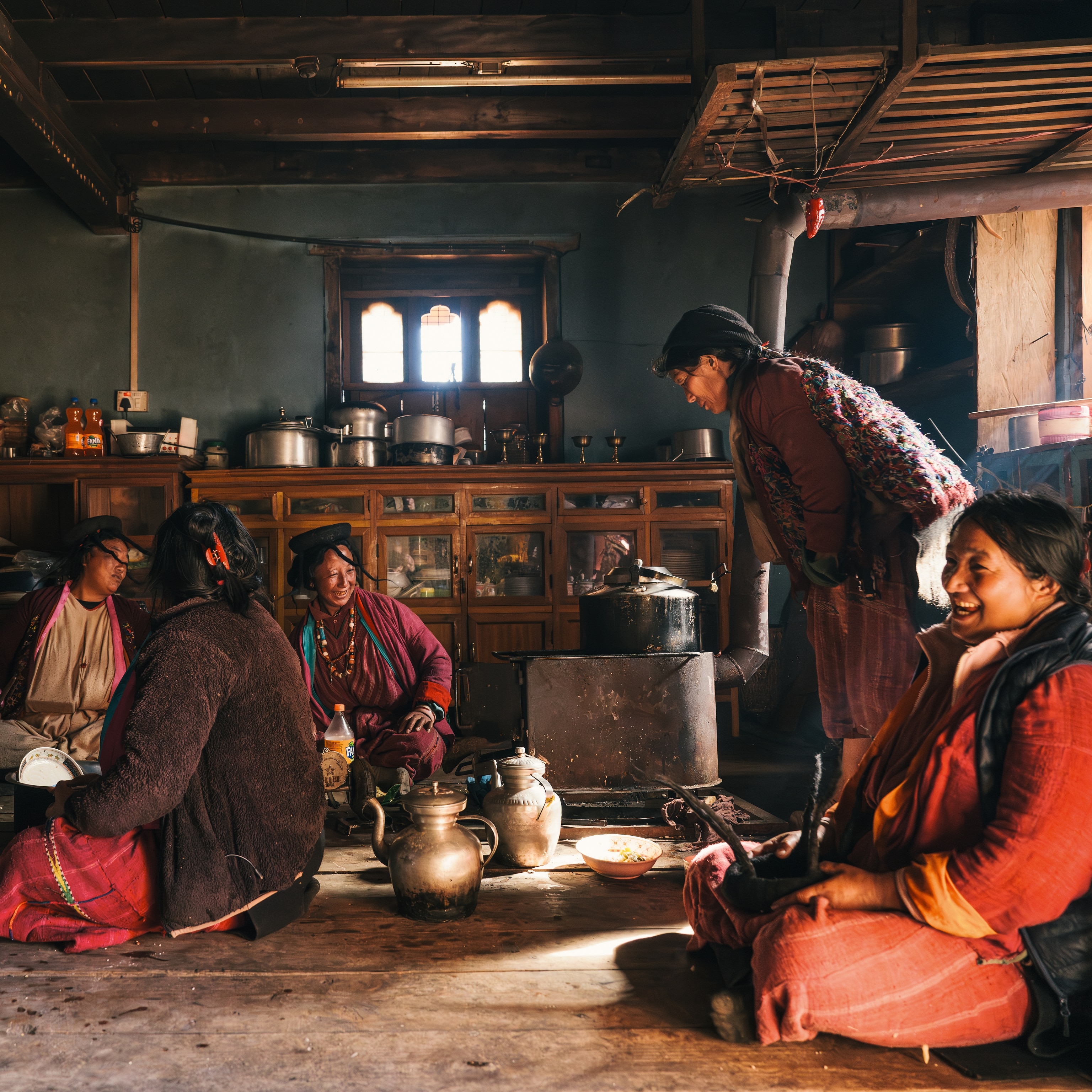
Bolivian gravediggers unearth human skulls from the communal plots in La Paz’s sprawling General Cemetery to prepare for tomorrow’s party. Shovels cut through the sour soil until the unmistakable clink of metal against bone, then lift the muddy faces to formation on a stone ledge. The crowd gathered in the rain offers coca leaves, neon soda, and sprinkles of alcohol to each cranium before sticking lit cigarettes into their decaying mouths and topping with flower crowns. As the high-altitude sun emerges, the priest arrives to don vestments and give a blessing over candles sticking out of the ground.
The following morning, thousands of devotees carry their own skulls in cabinets from the shrines in their homes to the cemetery for Día de las Ñatitas, or Day of the Ñatitas–a sweet diminutive for these revered skulls, literally meaning "pug-nosed ones"–then pray, sing, and dance through the city streets. Observed by the country's second largest indigenous group, the Aymara, the massive annual festival on November 8 combines Catholicism with precolonial Inca beliefs to give gratitude to the spirits occupying the ñatitas, whether buried or displayed throughout the year.











“No matter where you are, you think about [the ñatitas] and ask for whatever you want and need: to be good at your studies, for health, and protection,” explains participant Lais Mejia A. Keeping a ñatita in one’s home is considered by many people to provide a great advantage, since the dead are thought to have power to influence all aspects of life, like love, money, business, and safety.
Perhaps no one keeps more of this security in their house than Elizabeth “Eli” Portugal Coronez de Aduviri, nicknamed the “Queen” of the nearby cemetery. Seventy-three ñatitas–wearing knit hats with their names embroidered on them–occupy a place of honor in a special room. Rays of alpine sun peek through spaces in the corrugated roof. Stacked in rows on metal shelves, the skulls stare back at the utilitarian wooden benches surrounding local media accolades, a shrine to Saint Bombori, and flower vases on the floor, from which a dog tries to drink before being shooed away. Pastel candies and stacks of cigarettes stand ready for offering. Eli cares for these skulls as if members of her family.
At seven, when Eli started to smoke, a teacher noticed she could tell the future in the burning ashes. Her connection to the spirit realm has grown stronger ever since.



Every first Monday of the month, Eli claims to dream that the immortal call her to the cemetery. She goes to them, she says, sometimes waking up smelling like alcohol. “My soul goes out. It’s not that I feel I die, but I’m part of them.”
The 51-year-old now looks after the community’s orphaned ñatitas for those traveling or unable to meet the demands.
“It’s very important since I have this connection to them,” says Eli about Día de las Ñatitas. “On this day, it’s a reminder that I have an out-of-body experience. I’m grateful to God that I have this gift.”
Source of power
Nurturing the bond with the spiritual world pays off–one of Eli’s 73 ñatitas recently revealed through a dream the culprit of a robbery. According to the country’s daily newspaper Página Siete, five skulls also sit on the police investigative unit of El Alto, the neighborhood perched above the cemetery, and helped solve a murder case last year.

The Andean belief that heads transfer wisdom and strength to confront problems may have originated in the legendary pre-Inca empire of Tiwanaku, which had its epicenter in this part of Bolivia. Traces of the ancient traditions are everywhere. Stone faces from around 300 C.E. adorn the sandstone walls of the semisubterranean Temple near the sacred shores of Lake Titicaca on the altiplano, the high plateau in the Andes where the Aymara originated. Sculptures of puma-headed warriors hold a knife in one hand and a severed human head in the other.
According to anthropologist Milton Eyzaguirre, whose research focuses on the Andean concept of dying, there’s a straightforward reasoning behind the custom. "Once you have the head of your enemy, you have their power," says Eyzaguirre, explaining the iconography from behind his desk in his cluttered office at the National Museum of Ethnography and Folklore. “We can see in fabrics or ceramics that we used to have these headhunters.” Although skulls have long been venerated in this region, the exact start of the current celebration remains unclear. “Unfortunately, there’s no complex information about [Día de las Ñatitas],” continues Eyzaguirre, who wrote the book on ñatitas. He ties the pre-Hispanic observance to the cycle of the seasons.
Around the time of autumn planting, the Aymara people–under Inca rule after the fall of the Tiwanaku empire–would call upon Supay, the god of death and ruler of the Ukhu Pacha, the Inca underworld, splashing alcohol on the fields “to give more fertility to the soil and humans, and to be more productive in mining.” Upon arrival in the 16th century, the Spanish tried to suppress these practices which they considered veneration of the devil. The expression of beliefs persisted, but underground. In the 1970s, waves of farmers moved from rural areas into La Paz to find work, and the rituals became more public.


The party for these rituals start on the first and second of November with Día de los Muertos (Day of the Dead), which honors ancestors’ return to Earth, then continues later in the week, remembering forgotten spirits that occupy skulls with unique identities on Día de las Ñatitas. During spring harvest time in Bolivia, the monthlong Carnival celebrations end with the symbolic burial of a beloved mischievous character that spreads joy, Pepino, marking the end of winter when spirits rule.
Digging up graves or keeping skulls in the living room may sound macabre in some cultures. Instead of fear, the Aymaran face mortality with joyful folk music and dancing on Día de las Ñatitas. Although practices became commercialized businesses in recent years, Eyzaguirre affirms, “For Aymara, death means life.”
Spiritual business
After a near-death experience–getting struck by lightning at nine years old–Kevin Juan Siñani Catacora woke up with scar on his back and the power to tell the future. “People know me as clairvoyant.” For a pack of cigarettes and 20 bolivianos (around three dollars), Kevin answers a question: wrapping cigarettes into two bundles like dynamite, lighting them in the ground, and studying the slow burn with practiced concentration to help those who need business or legal advice. Kevin charges a steep 300 bolivianos (43 dollars, about one-fifth the average monthly salary in La Paz) for offerings and prayers to the deceased buried in the General Cemetery.




From a culture that wants to communicate with the dead, business possibilities boom for spiritual leaders like Kevin, Eli, and the yatiri, or Aymaran witch doctors that attempt to connect with another dimension. But the city cemetery faces a real limiting factor: sheer space. The aisles stretch endlessly, with tombs stacked four to seven high, depending upon how much a family pays.
“Around 15 thousand people die in La Paz per year. We [accommodate] one-third.” Other burials use private or illegal spaces, explains Director of the General Cemetery Ariel Conitzer in his office with a view of visitors singing prayers or picnicking in company of the departed.
Gravesites are leased, and after a fixed period of time, corpses are relocated to a smaller box. “They kind of bend the body,” says Conitzer.
When future generations lapse in payment, remains are removed, incinerated, and poured into a common grave, like one of several dug up for Día de las Ñatitas. Skulls may be brokered by cemetery workers during this transition. Other ñatitas–as in the house of local Angela Vargas–get purchased from a medical school. Few people keep the cranium of a relative, like one woman who prefers to be called Carmen for fear of her (living) family’s discovery that she intercepted the gravediggers’ transfer. She now visits her brother’s skull on Eli’s shelf.
However becoming part of daily lives of Aymaran families, these ñatitas receive thanks from thousands on the annual celebration. Others remain skeptical: “The Church has asked me to limit their participation. I said do whatever you usually do.” After all, Conitzer concludes, “They are just skulls.”
Life and Death
On Día de las Ñatitas, the saints in the Church of the General Cemetery stand covered in blue tarps, shielding their hardened eyes from the crowd that burst through the doors. The faithful carry wood and glass boxes holding shrines to ñatitas dressed up for the special day: Cigarettes dangle from bone jaws, sunglasses or cotton balls protect the eye sockets, and flower crowns top the craniums, prayed over in the center of the church.
Kevin’s group hangs purple streamers and balloons over the overturned grave site. Families spread picnic blankets to share a meal next to the honored. At midday, Eli’s friends start dancing in feathered and sequined costumes. Their procession pours into the streets, twirling and drinking among traffic, carrying the petrified family members to party late into the night. Meanwhile, the gravediggers return the craniums and push their blanket of flowers into the communal grave until next year.

Representing modern-day Bolivia, Día de las Ñatitas blends Catholicism and indigenous beliefs to thank the spirits inhabiting skulls for their protection. Yet the bond between living and dead remains steadfast throughout the year. As Kevin concludes, “To die is just to finish what you are supposed to do in this world.”
You May Also Like
Go Further
Animals
- Octopuses have a lot of secrets. Can you guess 8 of them?
- Animals
- Feature
Octopuses have a lot of secrets. Can you guess 8 of them? - This biologist and her rescue dog help protect bears in the AndesThis biologist and her rescue dog help protect bears in the Andes
- An octopus invited this writer into her tank—and her secret worldAn octopus invited this writer into her tank—and her secret world
- Peace-loving bonobos are more aggressive than we thoughtPeace-loving bonobos are more aggressive than we thought
- Why are these emperor penguin chicks jumping from a 50-foot cliff?Why are these emperor penguin chicks jumping from a 50-foot cliff?
Environment
- U.S. plans to clean its drinking water. What does that mean?U.S. plans to clean its drinking water. What does that mean?
- Food systems: supporting the triangle of food security, Video Story
- Paid Content
Food systems: supporting the triangle of food security - Will we ever solve the mystery of the Mima mounds?Will we ever solve the mystery of the Mima mounds?
- Are synthetic diamonds really better for the planet?Are synthetic diamonds really better for the planet?
- This year's cherry blossom peak bloom was a warning signThis year's cherry blossom peak bloom was a warning sign
- The U.S. just announced an asbestos ban. What took so long?The U.S. just announced an asbestos ban. What took so long?
History & Culture
- This ancient cure was just revived in a lab. Does it work?This ancient cure was just revived in a lab. Does it work?
- See how ancient Indigenous artists left their markSee how ancient Indigenous artists left their mark
- Why Passover is one of Judaism’s most important holidaysWhy Passover is one of Judaism’s most important holidays
- Is this mass grave a result of contagion—or cannibalism?Is this mass grave a result of contagion—or cannibalism?
- The surprising story of how chili crisp took over the worldThe surprising story of how chili crisp took over the world
- We swapped baths for showers—but which one is better for you?We swapped baths for showers—but which one is better for you?
Science
- Why outdoor adventure is important for women as they ageWhy outdoor adventure is important for women as they age
- 4 herbal traditions used every day, all over the world4 herbal traditions used every day, all over the world
- Ground-level ozone is getting worse - here's what that meansGround-level ozone is getting worse - here's what that means
- Would your dog eat you if you died? Get the facts.
- Science
- Gory Details
Would your dog eat you if you died? Get the facts. - In a first, microplastic particles have been linked to heart diseaseIn a first, microplastic particles have been linked to heart disease
Travel
- Why it's high time for slow travel in Gstaad
- Paid Content
Why it's high time for slow travel in Gstaad - How citizen science projects are safeguarding Costa Rican pumasHow citizen science projects are safeguarding Costa Rican pumas






